Economy of Kyrgyzstan
The economy of Kyrgyzstan is heavily dependent on the agricultural sector. Cotton, tobacco, wool, and meat are the main agricultural products, although only tobacco and cotton are exported in any quantity. According to Healy Consultants, Kyrgyzstan's economy relies heavily on the strength of industrial exports, with plentiful reserves of gold, mercury and uranium.[19] The economy also relies heavily on remittances from foreign workers. Following independence, Kyrgyzstan was progressive in carrying out market reforms, such as an improved regulatory system and land reform. In 1998, Kyrgyzstan was the first Commonwealth of Independent States (CIS) country to be accepted into the World Trade Organization. Much of the government's stock in enterprises has been sold. Kyrgyzstan's economic performance has been hindered by widespread corruption, low foreign investment and general regional instability. Despite political corruption and regional instability, Kyrgyzstan is ranked 70th (as of 2019) on the ease of doing business index.
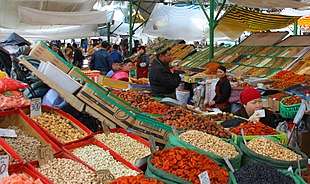 Osh Bazaar selling foods in Bishkek | |
| Currency | Kyrgyz som (KGS) |
|---|---|
| Calendar year | |
Trade organisations | WTO, CIS, EAEU, ECO, SCO, CISFTA |
Country group |
|
| Statistics | |
| Population | |
| GDP | |
| GDP rank | |
GDP growth |
|
GDP per capita | |
GDP per capita rank | |
GDP by sector |
|
| 10.6% (2020 est.)[5] | |
Population below poverty line | |
Labour force | |
Labour force by occupation |
|
| Unemployment | |
Main industries | small machinery, textiles, food processing, cement, shoes, lumber, refrigerators, furniture, electric motors, gold, rare earth metals |
| External | |
| Exports | |
Export goods |
|
Main export partners |
|
| Imports | |
Import goods |
|
Main import partners |
|
FDI stock | |
Gross external debt | |
| Public finances | |
| −3.2% (of GDP) (2017 est.)[7] | |
| Revenues | 2.169 billion (2017 est.)[7] |
| Expenses | 2.409 billion (2017 est.)[7] |
| Economic aid | $50 million from the US (2001) |
Foreign reserves | |
Finance
On October 2012, International reserves and Foreign Currency Liquidity of Kyrgyzstan National Bank have reached US $1.96 bln, 8.6% of which is in gold. In 2012, to diversify the assets of Kyrgyzstan, the basket of currencies has been expanded by means of the Chinese yuan and the Singapore dollar. In 2012, 1 billion soms are to be spent for the purchase of gold. Gold proportion in international reserves has already grown to 8.6%. The National Bank plans to increase it to 12-15% in future.[20]
Industries
Agriculture

Agriculture remains a vital part of Kyrgyzstan’s economy and a refuge for workers displaced from industry. Subsistence farming has increased in the early 2000s. After sharp reductions in the early 1990s, by the early 2000s agricultural production was approaching 1991 levels. Grain production in the lower valleys and livestock grazing on upland pastures occupy the largest share of the agricultural workforce. Farmers are shifting to grain and away from cotton and tobacco. Other important products are dairy products, hay, animal feed, potatoes, vegetables, and sugar beets. Agricultural output comes from private household plots (55 percent of the total), private farms (40 percent), and state farms (5 percent). Further expansion of the sector depends on banking reform to increase investment, and on market reform to streamline the distribution of inputs. Land reform, a controversial issue in Kyrgyzstan, has proceeded very slowly since initial legislation in 1998.[21] The irrigation infrastructure is in poor condition. Agriculture contributes about one-third of the GDP and more than one-third of employment.
Forestry
Only 4 percent of Kyrgyzstan is classified as forested. All of that area is state-owned, and none is classified as available for wood supply. The main commercial product of the forests is walnuts.[21]
Fishing
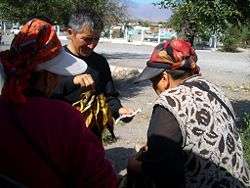
Kyrgyzstan does not have a significant fishing industry. In 2002 aquaculture contributed 66 percent of the country’s total output of 142 metric tons of fish, but in 2003 the aquaculture industry collapsed, producing only 12 of the country’s total of 26 metric tons.[21]
Mining and minerals
In the post-Soviet era, mining has been an increasingly important economic activity. The Kumtor Gold Mine, which opened in 1997, is one of the largest gold deposits in the world. New gold mines are planned at Jerooy and Taldy–Bulak, and a major gold discovery was announced in late 2006 at Tokhtonysay. The state agency Kyrgyzaltyn owns all mines, many of which are operated as joint ventures with foreign companies. Uranium and antimony, important mineral outputs of the Soviet era, no longer are produced in significant amounts. Although between 1992 and 2003 coal output dropped from about 2.4 million tons to 411,000 tons, the government plans to increase exploitation of Kyrgyzstan’s considerable remaining deposits (estimated at 2.5 billion tons) in order to reduce dependency on foreign energy sources. A particular target of this policy is the Kara–Keche deposit in northern Kyrgyzstan, whose annual output capability is estimated at between 500,000 and 1 million tons. The small domestic output of oil and natural gas does not meet national needs.[21]
Industry and manufacturing
In the post-Soviet era, Kyrgyzstan’s industries suffered sharp reductions in productivity because the supply of raw materials and fuels was disrupted, and Soviet markets disappeared. The sector has not recovered appreciably from that reduction; if gold production is not counted, in 2005 industry contributed only 14 percent of the gross domestic product (GDP). Investment and restructuring have remained at low levels, and the electricity industry (traditionally an important part of industry’s contribution to GDP) has stagnated in recent years. Government support is moving away from the machine industries, which were a major contributor to the Soviet economy, toward clothing and textiles. Food processing accounted for 10 to 15 percent of industrial production until encountering a slump in 2004. In recent years, the glass industry has surpassed clothing and textiles in investment received and as a contributor to GDP. In the early 2000s, the construction industry has grown steadily because of large infrastructure projects such as highways and new gold mines. Housing construction, however, has lagged because of low investment.[21]
Energy
More than ninety percent of electricity produced is hydroelectric and the country could produce much more of such clean energy and export to its neighbors and the region. Even though Kyrgyzstan has abundant hydro resources, only less than ten percent of its potential has been developed so far. It has limited deposits of fossil fuels and most of its natural gas imports come from Uzbekistan, with which Kyrgyzstan has had a series of imperfect barter agreements. Per capita energy consumption is high considering average income, and the government has no comprehensive plan to reduce demand. Up to 45 percent of electricity generated, especially in winter time, is diverted illegally or leaks from the distribution system. Hydroelectric plants generate some 92.5 percent of domestically consumed electricity, and three commercial thermoelectric plants are in operation. Because of its rich supply of hydroelectric power, Kyrgyzstan sends electricity to Kazakhstan and Uzbekistan in return for fossil fuels. A new hydroelectric plant on the Naryn River at Kambar–Ata would supply power to parts of China and Russia, improving Kyrgyzstan’s export situation and domestic energy supply. The plant was completed in August 30, 2010. An antiquated infrastructure and poor management make Kyrgyzstan more dependent on foreign energy in winter when water levels are low. In the early 2000s, Kyrgyzstan was exploiting only an estimated 10 percent of its hydroelectric power potential. In 2001 Kyrgyzstan had about 70,000 kilometers of power transmission lines served by about 500 substations. Kyrgyzstan would be a member of the Shanghai Cooperation Organization’s Asian Energy Club, which Russia proposed in 2006 to unify oil, gas, and electricity producers, consumers, and transit countries in the Central Asian region in a bloc that is self-sufficient in energy. Other members would be China, Kazakhstan, Tajikistan, and Uzbekistan.[21]
Kyrgyzstan is a partner country of the EU INOGATE energy programme, which has four key topics: enhancing energy security, convergence of member state energy markets on the basis of EU internal energy market principles, supporting sustainable energy development, and attracting investment for energy projects of common and regional interest.[22]
The South Korean style manufactured bituminous coal called yeontan (йонтан) is gaining popularity in Kyrgyzstan's energy industrial scene.[23][24]
Services
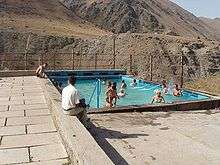
Substantial post-Soviet growth in the services sector is mainly attributable to the appearance of small private enterprises. The central bank is the National Bank of the Kyrgyz Republic, which nominally is independent but follows government policy. Although the banking system has been reformed several times since 1991, it does not play a significant role in investment. High interest rates have discouraged borrowing. A stock market opened in 1995, but its main function is trading in government securities. Because of the Akayev regime’s economic reforms, many small trade and catering enterprises have opened in the post-Soviet era. Although Kyrgyzstan’s mountains and lakes are an attractive tourist destination, the tourism industry has grown very slowly because it has received little investment. In the early 2000s, an average of about 450,000 tourists visited annually, mainly from countries of the former Soviet Union.[21]
External trade
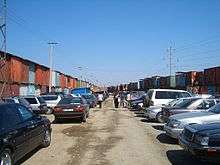
Kyrgyzstan's principal exports, which go overwhelmingly to other CIS countries, are nonferrous metals and minerals, woolen goods and other agricultural products, electric energy, and certain engineering goods. In turn, the Republic relies on other former Soviet states for petroleum and natural gas, ferrous metals, chemicals, most machinery, wood and paper products, some foods, and most construction materials. In 1999, Kyrgyz exports to the U.S. totaled $11.2 million, and imports from the U.S. totaled $54.2 million. Kyrgyzstan exports antimony, mercury, rare-earth metals, and other chemical products to the U.S., and it imports grain, medicine and medical equipment, vegetable oil, paper products, rice, machinery, agricultural equipment, and meat from the U.S.
Reexport of China-made consumer goods to Kazakhstan and Russia, centered on Dordoy Bazaar in Bishkek, and to Uzbekistan, centered on Kara-Suu Bazaar in Osh Region, is particularly important; it is thought by some economists to be one the country's two largest economic activities.[25]
The Kyrgyzstan Government has reduced expenditures, ended most price subsidies, and introduced a value added tax. Overall, the government appears committed to transferring to a free market economic system by stabilizing the economy and implementing reforms, which will encourage long-term growth. These reforms led to Kyrgyzstan's accession to the WTO on December 20, 1998.
Investment
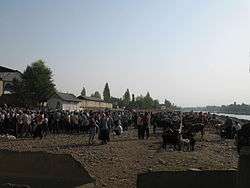
The stock market capitalisation of listed companies in Kyrgyzstan was valued at $42 million in 2005 by the World Bank.[26]
Taxation
The tax regime in the Kyrgyz Republic is administered by the State Tax Service. Collected taxes reached 18.1% of GDP in 2012.[27]
Macro-economic trend
This is a chart of trend of gross domestic product of Kyrgyzstan at market prices estimated by the International Monetary Fund and EconStats with figures in millions of Kyrgyz Soms.[28]
| Year | Gross Domestic Product | US Dollar Exchange |
|---|---|---|
| 1995 | 16,146 | 10.80 Soms |
| 2000 | 65,358 | 47.77 Soms |
| 2005 | 100,116 | 41.01 Soms |
| 2010 | 219,000 | 47.00 Soms |
| 2012 | 320,000 | 47.50 Soms |
For purchasing power parity comparisons, the international dollar is exchanged at 9.40 Soms only.
Current GDP per capita of Kyrgyzstan shrank by 54% in the 1990s.[29] Mean wages were $0.85 per man-hour in 2009 and this rate represented underemployment when compared to effective market pay. In the first half of 2012, Kyrgyz economy shrank by 5.8%. This downturn was largely due to decline in gold production at the Kumtor mine.[30]
The budget deficit in mid-2012 was 23-billion soms and accounted for 7% of GDP while the target was to reduce it to 6%.[31]
The following table shows the main economic indicators in 1992–2017.[32]
| Year | 1992 | 1995 | 2000 | 2005 | 2006 | 2007 | 2008 | 2009 | 2010 | 2011 | 2012 | 2013 | 2014 | 2015 | 2016 | 2017 |
|---|---|---|---|---|---|---|---|---|---|---|---|---|---|---|---|---|
| GDP PPP (current int'l dollars) |
8.07 Bln. | 6.20 Bln. | 8.12 Bln. | 10.98 Bln. | 11.67 Bln. | 13.00 Bln. | 14.26 Bln. | 14.78 Bln. | 14.89 Bln. | 16.10 Bln. | 16.39 Bln. | 18.47 Bln. | 19.56 Bln. | 20.54 Bln. | 21.60 Bln. | 22.97 Bln. |
| GDP per capita PPP (current int'l dollars) |
1,822 | 1,237 | 1,649 | 2,115 | 2,223 | 2,458 | 2,666 | 2,728 | 2,719 | 2,901 | 2,894 | 3,198 | 3,318 | 3,411 | 3,517 | 3,667 |
| GDP growth (real) |
... | −5.4 % | 5.4 % | 2.6 % | 3.1 % | 8.5 % | 7.6 % | 2.9 % | −0.5 % | 6.0 % | −0.1 % | 10.9 % | 4.0 % | 3.9 % | 3.8 % | 4.5 % |
| Inflation (in Percent) |
... | 42.1 % | 19.7 % | 4.3 % | 5.6 % | 10.2 % | 24.5 % | 6.8 % | 8.0 % | 16.6 % | 2.8 % | 6.6 % | 7.5 % | 6.5 % | 0.4 % | 3.2 % |
| Government debt (Percentage of GDP) |
... | ... | 122 % | 86 % | 73 % | 57 % | 48 % | 58 % | 60 % | 49 % | 49 % | 46 % | 52 % | 65 % | 58 % | 59 % |
Other statistics
Investment (gross fixed): 17% of GDP (2004 est.)
Household income or consumption by percentage share:
- lowest 10%: 3.9%
- highest 10%: 23.3% (2001)
Distribution of family income - Gini index: 27.3 (2017)[33]
Agriculture - products: tobacco, cotton, potatoes, vegetables, grapes, fruits and berries; sheep, goats, cattle, wool, dairy products[34]
Industrial production growth rate: 6% (2000 est.)
Electricity
- production: 11,720 GWh (2002)
- consumption: 10,210 GWh (2002)
- exports: 1,062 GWh (2002)
- imports: 375 GWh (2002)
Electricity - production by source:
- fossil fuel: 7.6%
- hydro: 92.4%
- other: 0% (2001)
- nuclear: 0%
Oil:
- production: 2,000 barrels per day (320 m3/d) (2001 est.)
- consumption: 20,000 barrels per day (3,200 m3/d) (2001 est.)
- exports: NA
- imports: NA
Natural gas:
- production: 16 million m³ (2001 est.)
- consumption: 2.016 billion m³ (2001 est.)
- exports: 0 m³ (2001 est.)
- imports: 2 billion m³ (2001 est.)
Current account balance: $-87.92 million (2004 est.)
Exports - commodities: cotton, wool, meat, tobacco; gold, mercury, uranium, natural gas, hydropower; machinery; shoes
Imports - commodities: oil and gas, machinery and equipment, chemicals, foodstuffs
Reserves of foreign exchange & gold: $498.7 million (2004 est.)
Exchange rates: soms per US dollar - 41.731 (2004), 43.6484 (2003), 46.9371 (2002), 48.378 (2001), 47.7038 (2000), 69.85 (2020)
See also
References
- "World Economic Outlook Database, April 2019". IMF.org. International Monetary Fund. Retrieved 29 September 2019.
- "World Bank Country and Lending Groups". datahelpdesk.worldbank.org. World Bank. Retrieved 29 September 2019.
- "Population, total". data.worldbank.org. World Bank. Retrieved 22 August 2019.
- "World Economic Outlook Database, October 2019". IMF.org. International Monetary Fund. Retrieved 15 November 2019.
- "World Economic Outlook Database, April 2020". IMF.org. International Monetary Fund. Retrieved 16 June 2020.
- "Global Economic Prospects, June 2020". openknowledge.worldbank.org. World Bank. p. 80. Retrieved 10 June 2020.
- "The World Factbook". CIA.gov. Central Intelligence Agency. Retrieved 24 March 2019.
- "Poverty headcount ratio at national poverty lines (% of population) - Kyrgyz Republic". data.worldbank.org. World Bank. Retrieved 20 March 2020.
- "Europe Central Asia Economic Update, Spring 2020 : Fighting COVID-19". openknowledge.worldbank.org. World Bank. p. 57, 58. Retrieved 9 April 2020.
- "GINI index (World Bank estimate)". data.worldbank.org. World Bank. Retrieved 20 March 2020.
- "Human Development Index (HDI)". hdr.undp.org. HDRO (Human Development Report Office) United Nations Development Programme. Retrieved 11 December 2019.
- "Inequality-adjusted HDI (IHDI)". hdr.undp.org. UNDP. Retrieved 22 May 2020.
- "Labor force, total - Kyrgyz Republic". data.worldbank.org. World Bank. Retrieved 2 November 2019.
- "Employment to population ratio, 15+, total (%) (national estimate)". data.worldbank.org. World Bank. Retrieved 3 February 2020.
- "Unemployment rate". stat.kg. National Statistical Committee of Kyrgyz Republic. Retrieved 8 December 2019.
- "Unemployment, youth total (% of total labor force ages 15-24) (national estimate) - Kyrgyz Republic". data.worldbank.org. World Bank. Retrieved 3 February 2020.
- "Ease of Doing Business in Kyrgyz Republic". Doingbusiness.org. Retrieved 2017-11-29.
- "Kyrgyzistan - WTO Statistics Database". World Trade Organization. Retrieved 24 March 2019.
- "Kyrgyzstan Company Registration". Healy Consultants. Retrieved 9 September 2013.
- "International Reserves of Kyrgyzstan National Bank Reached $1.96 bln". The Gazette of Central Asia. Satrapia. 20 October 2012.
- Kyrgyzstan country profile. Library of Congress Federal Research Division (January 2007). This article incorporates text from this source, which is in the public domain.
- INOGATE website
- Byeon (변), I-cheol (이철) (2011-08-05). '한국 연탄'으로 '한류' 지핀다. Nocut News (in Korean). Retrieved 2011-08-21.
- В зданиях бюджетных учреждений Ленинского района будут установлены современные отопительные котлы. Zamandash Press (in Russian). 2010-12-01. Archived from the original on 2012-03-22. Retrieved 2011-08-21.
- Sebastien Peyrouse, Economic Aspects of China-Central Asia Rapprochment Archived February 7, 2009, at the Wayback Machine. Central Asia - Caucasus Institute, Silk Road Studies Program. 2007. p.18.
- Data - Finance Archived April 5, 2010, at the Wayback Machine
- Barreto, Ruben; Sinha, Rajib (2014-12-22). "Implementing a Tax Administration System in the Kyrgyz Republic". Rochester, NY. SSRN 2574031. Cite journal requires
|journal=(help) - "Kyrgyz Economy Shrank by 5.8% in the First Half of 2012". The Gazette of Central Asia. Satrapia. 24 July 2012. Retrieved 9 August 2012.
- "400 Projects to Be Postponed in Kyrgyzstan Due to Lack of Financing". The Gazette of Central Asia. Satrapia. 4 October 2012.
- "Report for Selected Countries and Subjects". Retrieved 2018-09-09.
- World Bank (1988-01-01). "GINI Index for the Kyrgyz Republic". FRED, Federal Reserve Bank of St. Louis. Retrieved 2019-09-21.
- Kazakhstan: Kyrgyzstan hopes to expand exports of dairy products to Southern Kazakhstan
External links
- Minister wants bigger role for local mining firms
- Kyrgyz-North America Trade Council, New York USA
- American Chamber of Commerce in Kyrgyz Republic, Bishkek
- International Business Council, Bishkek
- Bishkek Business Club
- Kyrgyzstan: Kyrgyzstan has great potential to become a center of organic production in Central Asia
- Tariffs applied by Kyrgyzstan as provided by ITC's Market Access Map, an online database of customs tariffs and market requirements.